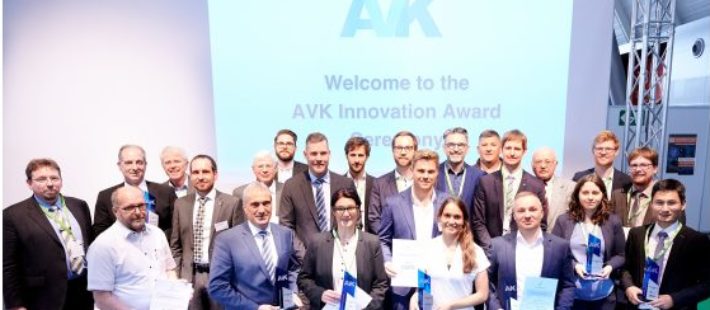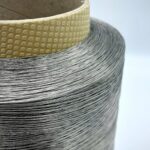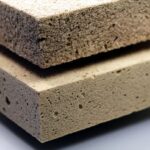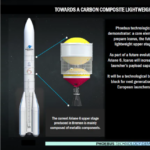The AVK – the German Federation of Reinforced Plastics – has presented its prestigious Innovation Awards in three categories. They recognise new and pioneering innovations and place a particular attention on sustainability. The jury, comprising experts in the composites industry, were impressed by the high quality of the submissions and selected the winners in three categories: “Products and Applications”, “Processes”, and “Research and Science”.
In the category “Innovative Products/Applications”, BÜFA Composite Systems GmbH & Co. KG, Rastede, was awarded first place for its RTM-light component with a Class A surface. CEAD B.V., Delft, was the winner in the area of “Innovative Processes” with its development of an additive manufacturing process which permits the use of continuous fibres in large components required for industrial applications. In the category “Research and Science”, the Technical Universities of Clausthal and Dresden shared first place for their development of a simulation-based method that offers faster infiltration of semi-finished textile reinforcement products via temporary flow channels.
1st Place in the Category “Innovative Products and Applications”
BÜFA Composites Systems GmbH & Co. KG, Rastede: “An efficient and ecological route to an RTM-light component with a Class A surface”
The award was presented for the development of a special type of resin. BÜFA®-VE 6520 RTM Class A resin enables manufacturers to realise Class A GRP surfaces at just 20°C in a simple RTM-light process. Fibre print and shrink marks caused by metal inserts, flow channels, etc. – common problems with GRP – simply disappear.
Special low-profile additives with a special formulation (EP-BisA-VE) not only compensate for shrinkage but also ensure excellent mechanical properties and a heat deflection temperature of over 100°C. In addition, they offer very good adhesion to gelcoat, sandwich materials and semi-finished textile products. The resin system requires no buffer layers. This reduces the processing time for the component by approx. 25%. Eliminating manual tasks helps to stabilise the process and reduces surface defects by more than 40%. It also cuts VOC emissions by 50%.
SMC/BMC processes have been producing Class A surfaces using low-profile additives for many years – but mostly at temperatures above 120°C. The BÜFA®-VE 6520 RTM Class A resin can be processed at room temperature. No additional buffer layer is required, e.g. a first layer (fleece + resin in hand lay-up) or a barrier coat (spray application). Moreover, metal inserts and perforations, flow channels and impacts from sandwich cores leave no marks. The low-profile additives in a bisphenol A epoxy vinyl ester formulation compensate for the shrinkage, improve surface quality and reduce the stresses in the component itself. The resin has a very low viscosity and is therefore ideal for use in vacuum injection and RTM processes, in the leisure, boat, sanitary or tank construction sectors.
The process with the new resin generates less waste, overspray and excess resin – greatly reducing the waste stream. It reduces the number of steps required, even during reworking, because there are fewer air pockets/prior deformations and even fewer rejects.
1st Place in the Category “Innovative Processes”
CEAD B.V.: “Continuous Fiber Additive Manufacturing (CFAM) – 3D printing of large composites components for industrial applications”
Until 2017, additive manufacturing with continuous fibres was impossible, e.g. for the production of cladding elements, exterior panels for trains or autoclave moulds. The development of CFAM technology now enables continuous fibres to be used in high-speed, 3D printing of large format components. It can be used to manufacture parts with dimensions of up to 4 m x 2 m x 2 m x 1.5 m. Production plants can print these products with an average output of 15 kg/h and a maximum output of 25 kg/h. The process for combining continuous fibres and thermoplastic materials on this scale has already been patented. It uses a single-screw extruder which functions with both glass and carbon fibres as well as practically all thermoplastic materials, from PP to PEEK.
CFAM technology can be used to produce large and complex composite parts that are manufactured in small quantities, such as facade cladding or cabin covers. It can also be used to print moulds for making composite components in autoclaves.
Since these areas of production require a great deal of manual labour, they are often relocated to the Far East. The ability to print with continuous fibres means these components can now be produced locally – quickly and affordably. It also makes it easier to access spare parts for repairs and reduces lead times for moulds and end parts.
1st Place in the Category “Research and Science”
Institute of Polymer Materials and Plastics Technology (PuK), TU Clausthal and Institute of Textile Machinery and Textile High Performance Materials Technology (ITM), TU Dresden: “Development of a simulation-based process for the rapid impregnation of large and complex composite stuctures based on n ovel semi-finished textile products with integrated temporary flow channels”
The aim of the research project was to develop a simulation-based method for integrating temporary flow channels into technical textiles. These channels in the reinforced semi-finished products close after infiltration is complete. The project focused on reducing the infiltration time for large-area components. The method developed uses temporary flow channels to precisely adjust the permeability of the semi-finished textile products. Importantly, the process ensures the excellent mechanical properties of FRP components and a homogeneous arrangement of reinforcing threads in the FRP component. It achieves this by closing the flow channels once infiltration has been completed. No flow aids are required.
The new technique can reduce infiltration times for the semi-finished product by up to 50%. The novel semi-finished product enables FRP components to be manufactured quickly, economically and sustainably with low cycle times – significantly reducing component costs.
The production of high-strength and resource-efficient fibre composite components requires complete impregnation of fibre semi-finished products with a thermosetting resin system. These resins are most commonly introduced by infusion and injection processes – especially for large components. Flow aids or very slow infiltration with a high pot life are usually required to ensure complete impregnation.
The new method creates temporary, fibre-based channels in the textile structure that close once the resin has fully infused. For the process, the researchers developed special rovings and performed simulation calculations to calculate their distribution. The technique increases the permeability of the semi-finished products by up to 100%. The fibre reinforcement is also homogeneous around the channels.
Simulating the temporarily increased permeability or infusion, while taking account of dual-scale effects, allows manufacturers to develop permeability-adjusted, reinforced, semi-finished products in a quick and targeted manner. It also eliminates the need for costly experiments based on trial and error. In the future, it may be possible to manufacture large fibre composite components, e.g. wind turbine rotor blades that cut resin use by at least 10% and reduce infusion times by around 50%. The elimination of flow aids during the infusion process also reduces production times, since no construction or removal of flow aids is required.
The research results also provide the basis for fast, large-scale production of geometrically complex 3D-moulded components using impregnation processes. The process is suitable for industrial use with comparatively little effort and expense. Existing technologies could be adapted for use with it and it is compatible with all known textile processes for the production of reinforcement structures.
An overview of all the winners in the three categories
Category “Innovative Products/Applications”
1st Place: “More efficient and ecological to Class A RTM-light-part with BÜFA®-VE 6520 RTM-Class A-Resin” – BÜFA Composite Systems GmbH & Co. KG, Rastede 2nd Place: “Modular Drilling Templates – 3D-Printing and CFRP composed” – Composite Technology Center GmbH, Stade 3rd Place: “Manual Lamination Tool – Simple and flexible tool for local fiber reinforcements” – M&A Dieterle GmbH Maschinen- und Apparatebau, Ottenbach
Category “Innovative Processes”
1st Place: “Continuous Fiber Manufacturing, 3D printing large composite parts for the industry sectors” – CEAD B. V., Delft 2nd Place: “Process development for functionalized composite structures with complex shaped hollow profiles (FuPro) – Brose Fahrzeugteile GmbH & Co. KG, Coburg 3rd Place: “Continuous Fieber Tailoring – Cost-efficient and highly automated manufacturing of near-net-shape preforms for the high-volume use of CFRP structures” – Fraunhofer Research Institution for Casting, Composite and Processing Technology IGCV, Augsburg
Category “Research and Science”
1st Place: “Rapid infiltration of textile reinforcement semi-finished products via temporary flow channels” – PuK, TU Clausthal; ITM, TU Dresden 2nd Place: “Composites 4.0: Sensor-integrated composite components– a collaborative research project by industry and science” – ARENA2036, Stuttgart, Germany 3rd Place: “Development of a textile-based material feed to increase the preform quality during stamp forming of reinforcing layers” – Institut für Textiltechnik der RWTH Aachen University, Aachen.
Source: AVK













